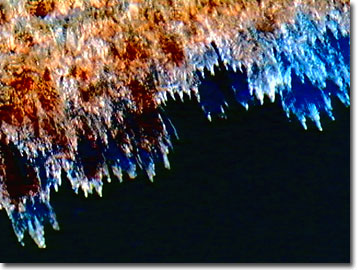Butterfly Wing Scale Digital Image Gallery
Black and White Helen Butterfly
Similar to the little black dress at a formal affair, the black and white Helen butterfly demonstrates the rule that sometimes less is more. The simple elegance of its black wings marked in white makes the species stand out among many of its more colorful brethren. The understated exquisiteness of the species is reflected in its common name, most likely given in honor of Helen of Troy, the great beauty of Greek mythology.

Geographic variation and reproductive isolation in the species has resulted in ten recognized subspecies of black and white Helen butterflies. Their wingspans range between 110 and 130 millimeters, which make them rather large butterflies. The upper sides of their wings are a velvety black with areas of translucent speckles between the veins. The hind wings of some subspecies feature lower surfaces that exhibit four creamy patches and a row of pale yellow submarginal crescents.
The black and white Helen is sometimes called the Oriental Papilio, but is scientifically known as Papilio nephelus. The species ranges from Northern India throughout Southeast Asia, and south into Malaysia. Often thriving in the low elevation Asian forests, these swallowtails enjoy living in areas adjacent to running water. Black and white Helen butterflies, considered common in Taiwan, may also often be seen in urban and suburban parks.
The larval food plants of the black and white Helen are useful to both the species and humans alike. The favorite of black and white Helen butterfly larvae is crocodile or satin wood, but they may also sometimes eat the leaves of citrus trees and lamk. Crocodile wood is highly valued by humans because it is well suited for carving and provides a finish and color similar to ivory. Lamk is considered useful because of the medicinal properties of the alkaloids and quinolines that can be isolated from its tissues. The butterfly larvae, however, gain something of a different nature from these plants. Black and white Helen's are noxious to predators due to the phytochemicals they ingest and sequester from the plants they feed on as caterpillars.
Black and White Helen Butterfly Images in Oblique Illumination
Wing Scale Array - In oblique light this array of the wing scales of the black and white Helen butterfly appears dark and wavy, like the sea during a storm.
Wing Scale Interference Patterns - In this high magnification image, interference patterns dancing across the wing scales of a black and white Helen butterfly can be easily seen. The grooves on their surfaces look similar to fingerprints.
Contributing Authors
Cynthia D. Kelly, Shannon H. Neaves, Laurence D. Zuckerman, and Michael W. Davidson - National High Magnetic Field Laboratory, 1800 East Paul Dirac Dr., The Florida State University, Tallahassee, Florida, 32310.
BACK TO THE BUTTERFLY WING SCALE IMAGE GALLERY
BACK TO THE DIGITAL IMAGE GALLERIES
Questions or comments? Send us an email.
© 1995-2025 by Michael W. Davidson and The Florida State University. All Rights Reserved. No images, graphics, software, scripts, or applets may be reproduced or used in any manner without permission from the copyright holders. Use of this website means you agree to all of the Legal Terms and Conditions set forth by the owners.
This website is maintained by our
Graphics & Web Programming Team
in collaboration with Optical Microscopy at the
National High Magnetic Field Laboratory.
Last Modification Friday, Nov 13, 2015 at 01:19 PM
Access Count Since January 21, 2003: 39893
Visit the website of our partner in introductory microscopy education:
|
|
